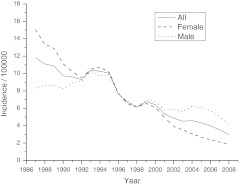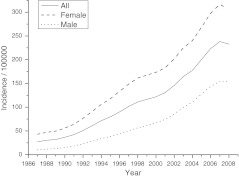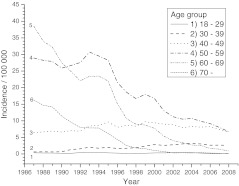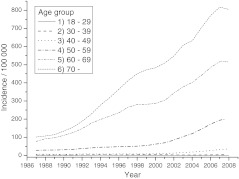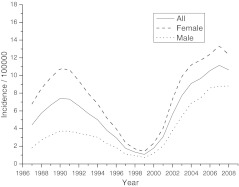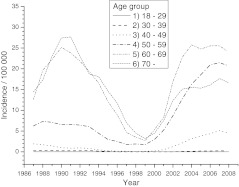Abstract
Purpose
Both tibial and femoral osteotomies have been used for the treatment of knee osteoarthritis (OA). Due to the clinical success of total knee arthroplasty (TKA) the current role and incidence of osteotomies remains unknown. The aim of this population-based study was to assess the incidence of osteotomies and compare it with that of knee arthroplasties.
Methods
From the Finnish National Hospital Discharge Register, we identified all patients, aged 18 years or more, who had undergone osteotomy for the treatment of knee OA between 1987 and 2008. The number of arthroplasties was extracted from the Arthroplasty Register.
Results
A total of 6,004 osteotomies were performed for 5,734 patients. The average osteotomy incidence has steadily decreased by 6.2%, and TKA incidence has increased by 9.8% annually. However, in patients aged less than 50 years the osteotomy incidence has increased by 1.4% annually. The decline of osteotomy incidence has been steeper in females than in males (9.0% vs. 3.6%), and during the last decade osteotomies were more commonly performed in male patients.
Conclusion
Incidence of osteotomies for the treatment of knee OA has decreased during last two decades. However, in patients aged less than 50 years the osteotomy incidence has slightly increased. In a comparison by gender, females are more likely to undergo arthoplasty than osteotomy, and it would therefore appear that the current use of osteotomies is predominantly reserved for the treatment of knee OA in relatively young males.
Introduction
Over the last three decades, both tibial and femoral osteotomies have been widely used for the treatment of osteoarthritis (OA) isolated to a single compartment of the knee. Over the past decade, the incidence of osteotomies has decreased because of the clinical success of total knee arthroplasty (TKA) [1]. Furthermore, at the same time, the number of unicondylar knee arthroplasties (UKA) has grown [2], which may also have contributed to the decreased number of osteotomies performed. However, symptomatic and radiographically mild to moderate knee OA in young and active patients is still commonly regarded as an indication for high tibial osteotomy [3–5].
Based on a review of the world medical literature, there are a limited number of studies concerning the incidence of tibial osteotomies in the treatment of knee OA. Wright et al. reported in their epidemiological analysis of tibial osteotomies in the United States and Canada between 1985 and 1990 that rates of tibial osteotomies are decreasing, particularly among elderly patients [6]. W-Dahl et al. reported in their study of surgery for knee osteoarthritis in younger patients that the number of high tibial osteotomies has halved between 1998 and 2007 in patients less than 55 years of age in Sweden [7].
The purpose of this registry-based study was to assess the incidence of osteotomies around the knee for OA performed in Finland between 1987 and 2008, and to compare it to that of knee arthroplasties performed over the same time period.
Patients and methods
The Finnish National Hospital Discharge Register (NHDR) lists all diagnoses resulting in hospitalisation and surgical procedures performed in Finland. Based on data recorded in the NHDR, we identified all patients aged 18 years or more who had undergone either tibial or femoral osteotomy for the treatment of symptomatic knee OA between 1987 and 2008. We used the International Classification of Diseases, 9th and 10th edition (ICD-9 and ICD-10), diagnosis codes used for primary, secondary, and post-traumatic knee OA, and surgical codes for femoral and tibial osteotomies, in our data extraction. All other indications for osteotomy than knee OA were excluded from the study. Numbers of TKA and UKA performed were extracted from the Finnish Arthroplasty Register, and the number of eligible patients of 18 years of age or older was obtained from Statistics Finland, both over the same time period.
The incidence of osteotomies and arthroplasties was calculated as the number of hospitalisations per 100,000 patients. Incidence was separately calculated for each study year, and was also analysed for both genders and for six different age groups (18–29, 30–39, 40–49, 50–59, 60–69, and ≥70). The incidence rate ratio (IRR) was calculated for annual increase/decrease, and this was used to compare the effect of the group (gender and age under 50 vs. 50 or over years) on incidence. The increase in IRR is presented as a percentage (e.g., IRR = 0.938 is shown as a 6.2% decrease) with a 95% confidence interval (95%CI). SPSS version 18.0 and STATA version 11.0 were used for analyses.
Results
A total of 6,004 osteotomies were performed for 5,734 patients between 1987 and 2008 in Finland. Approximately half (n = 3,032, 50.5%) of the operations were performed for female patients. The mean age of the patients was 54 (range, 18–86) years at the time of the operation. The most common indication for osteotomy was primary OA, accounting for 90.2% of cases (n = 5,414), followed by secondary OA (341 cases; 5.7%), post-traumatic OA (212 cases; 3.5%) and undefined OA (34 cases; 0.6%). The operation site was tibial in 2,207 (36.8%) cases and femoral in 121 (2.0%) cases. In 3,676 (61.2%) cases, it was unknown whether the operation site was tibial or femoral.
Between 1987 and 2008, the incidence of osteotomies has steadily decreased, on average by 6.2% annually. While the annual incidence of these procedures has markedly declined in both sexes, the decline has been significantly steeper in female patients (9.0% vs. 3.6%, IRR = 5.9%, 95%CI 5.0–6.8%, P < 0.001) (Fig. 1). At the same time, the incidence of TKA has increased annually by 9.8% on average. The incidence of TKA has increased significantly more in male than in female patients, by 12.4% and 8.9%, respectively (IRR = 3.3%, 95%CI 3.0–3.5, P < 0.001) (Fig. 2).
Fig. 1.
The incidence of osteotomies around the knee performed for treatment of knee OA
Fig. 2.
The incidence of total knee arthroplasty for the treatment of knee OA
The most prominent decrease in the incidence of osteotomies has taken place among older patients, i.e., patients aged more than 50 years (Fig. 3). In these patients, the incidence of osteotomies has declined annually by 10.3% on average, while the average annual incidence of TKAs has increased by 8.8%. However, in patients aged less than 50 years, the incidence of both osteotomy and TKA has increased (Fig. 3) by 1.4% and 8.8%, respectively (Figs. 3 and 4). The annual decrease in the incidence of osteotomies was significantly higher in the older age group (IRR = 11.5%, 95%CI 10.7–12.2%, P < 0.001), but there was no difference in the incidence of TKA (IRR = 0.0%, 95%CI −0.6 to 0.6%, P ≥ 0.9). The number of UKAs performed increased sharply after introduction of the Oxford unicompartmental knee arthroplasty, phase 3 (Biomet, Inc., Warsaw, IN, USA), in 1998. The number of operations was highest in 2006 (n = 514), and during recent years the number of operations has been steady or slightly decreasing (Figs. 5 and 6). In the year 2002 the incidences of UKAs and osteotomies were equal, and after that UKAs have been performed more than osteotomies.
Fig. 3.
The incidence of osteotomy by age groups for the treatment of knee OA
Fig. 4.
The incidence of total knee arthroplasty by age groups for the treatment of knee OA
Fig. 5.
The incidence of unicompartmental knee arthroplasty for the treatment of knee OA
Fig. 6.
The incidence of unicompartmental knee arthroplasty by age groups for the treatment of knee OA
Discussion
The overall incidence of osteotomies around the knee performed for treatment of symptomatic knee OA has steadily decreased over the last two decades. This decline has occurred in both female and male patients; however, the incidence has slightly increased for patients under 50 years. The reason behind the declining osteotomy figures may very well be the improved outcome of TKA in all patient groups during the last two decades. Additionally, UKAs have been performed in patients with less severe arthritis [8], which may have decreased the number of osteotomies performed.
In female patients, the decline in incidence has been steeper than that for male patients. Furthermore, during the last decade osteotomies were more commonly performed in male patients than in female patients. This must be considered controversial, as it has been shown that knee OA is more common among the female population, with female patients generally suffering worse symptoms and greater disability than male patients [9]. This is supported by the fact that TKAs and UKAs are more commonly performed in female patients.
Despite the fact that the overall incidence of osteotomies has decreased, it has, however, slightly increased in patients aged less than 50 years. This suggests that TKA has not totally replaced osteotomy in young and active patients, especially in males. Based on our findings, it is clear that the current role of osteotomies is minor in treatment of patients with knee OA aged more than 60 years.
There are some potential limitations to our study. For example, in almost half of cases we could not reliably identify the site of the osteotomy, i.e., whether it was performed on the tibia or the femur. We have made the assumption that most of these cases were high tibial osteotomies, which have historically been far more commonly used than femoral osteotomy. The strength of this study is our long-term population-based data, and also the fact that it combines data from two separate registries, which increases the reliability of our findings. The reliability of NHDR for reporting surgical operations has previously been reported to be high [10].
The incidence of osteotomies performed for treatment of knee OA has steadily decreased in Finland during the last two decades. The decline has been especially steep in the number of such procedures performed in female patients. However, the incidence of osteotomies has slightly increased in patients aged less than 50 years. As the reason for this phenomenon remains unclear, further studies are needed. In conclusion, it seems that the current role of osteotomies in treatment of knee OA is rather limited, as it is being used mainly in younger male patients.
Acknowledgements
We thank Bhubinder Mann for reviewing the manuscript and revising the English.
Conflict of interest
The authors declare that they have no conflict of interest.
References
- 1.Kurtz S, Mowat F, Ong K, Chan N, Lau E, Halpern M (2005) Prevalence of primary and revision total hip and knee arthroplasty in the United States from 1990 through 2002. J Bone Joint Surg Am. 87(A);7:1487–1497 [DOI] [PubMed]
- 2.Koskinen E, Paavolainen P, Eskelinen A, Pulkkinen P, Remes V. Unicondylar knee replacement for primary osteoarthritis—a prospective follow-up study of 1,819 patients from the Finnish Arthroplasty Register. Acta Orthop Scand. 2007;78(1):128–135. doi: 10.1080/17453670610013538. [DOI] [PubMed] [Google Scholar]
- 3.Wright JM, Crockett HC, Slawski DP, Madsen MW, Windsor RE. High tibial osteotomy. J Am Acad Orthop Surg. 2005;13(4):279–289. doi: 10.5435/00124635-200507000-00007. [DOI] [PubMed] [Google Scholar]
- 4.Wolcott M, Traub S, Efird C. High tibial osteotomies in the young active patient. Int Orthop. 2010;34:161–166. doi: 10.1007/s00264-009-0944-5. [DOI] [PMC free article] [PubMed] [Google Scholar]
- 5.Amendelo A, Bonasia DE. Results of high tibial osteotomy: review of the literature. Int Orthop. 2010;34:155–160. doi: 10.1007/s00264-009-0889-8. [DOI] [PMC free article] [PubMed] [Google Scholar]
- 6.Wright J, Heck D, Hawker G, Dittus R, Freund D, Joyce D, Paul J, Young W, Coyte P. Rates of tibial osteotomies in Canada and the United States. Clin Orthop. 1995;319:266–274. [PubMed] [Google Scholar]
- 7.W-Dahl A, Robertsson LL. Surgery for knee osteoarthritis in younger patients – A Swedish register study. Acta Orthop Scand. 2010;81(2):161–164. doi: 10.3109/17453670903413186. [DOI] [PMC free article] [PubMed] [Google Scholar]
- 8.Niinimäki T, Murray DW, Partanen J, Pajala A, Leppilahti J. Unicompartmental knee arthroplasties implanted for osteoarthritis with partial loss of joint space have high re-operation rates. Knee. 2011;18(6):432–435. doi: 10.1016/j.knee.2010.08.004. [DOI] [PubMed] [Google Scholar]
- 9.Hawker GA, Wright JG, Coyte PC, Williams JI, Harvey B, Glazier R, Badley EM. Differences between men and women in the rate of use of hip and knee arthroplasty. N Engl J Med. 2000;342(16):1016–1022. doi: 10.1056/NEJM200004063421405. [DOI] [PubMed] [Google Scholar]
- 10.Keskimäki I, Aro S. Accuracy of data on diagnosis, procedures and accidents in the Finnish hospital discharge register. Int J Health Sci. 1991;2:15–21. [Google Scholar]



